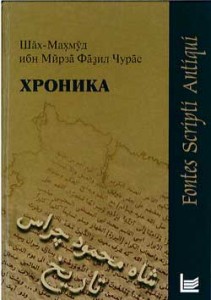Mahmud Churas’ untitled chronicle ranks as the most important historical composition from seventeenth century Xinjiang, a period for which we are relatively poorly served by local literature. Only one manuscript version of the text survives. At the beginning of the twentieth century this manuscript was in the possession of a wealthy Tashkent man, Baqi Jan Bay. The Russian Orientalist Bartold met Baqi during his trip to Turkistan in 1916, and obtained permission to remove the text to Saint Petersburg for copying. The Russian Revolution intervened and cut Turkistan off from the rest of Russia, and evidently the book was never returned to its owner. Instead it ended up in a library in Moscow. There it remained, largely unnoticed by scholars, until Oleg Akimushkin published an edition of the text, with Russian translation and extensive commentary, in 1976.
- Churās, Shāh Maḥmūd. Khronika. Kriticheskii tekst, perevod, kommentarii, issledovanie i ukaziteli O. F. Akumushkin. Moscow: Nauka, 1976.
 A second edition of Akimushkin’s work was released in 2010 (see right), sadly appearing shortly after the scholar’s passing. Akimushkin’s Russian translation is also available online, at the Vostochnaia literatura site.
A second edition of Akimushkin’s work was released in 2010 (see right), sadly appearing shortly after the scholar’s passing. Akimushkin’s Russian translation is also available online, at the Vostochnaia literatura site.
Well before this the text had been translated into Chaghatay, possibly by the author himself. One such Chaghatay work which closely resembles the Chronicle was also edited by Akimushkin, under the title Taʾrīkh-i Kāshghar. Another was published in Xinjiang under the title Chingiznamä. Most recently a Chaghatay translation of the Taʾrīkh-i Rashīdī with continuations including the Mahmud Churas text was edited and published by a team of Japanese and Uzbek researchers:
- Jalilov, Amanbek, Kawahara Yayoi, Sawada Minoru, Shinmen Yasushi, and Sunao Hori. Addendum to Tārīkh-i Rashīdī: Translation and Annotation with Introduction and Indices. Tokyo: NIHU Program Islamic Area Studies, 2008.
There has also been a Uyghur translation of sections of the text:
- Säidiyä khandanliqi tarikhigha dair materiyallar, trans. Häbibulla Eli (Qäshqär Uyghur näshriyati, 1988).
My aim in presenting this English translation here is not to provide a full-blown critical study of the text and its historical context. For that, please refer to Akimushkin’s edition. The translation will be posted in instalments over the coming months.
Notes:
- Numbers in round () brackets refer to page numbers in Akimushkin’s 1976 edition.
- Numbers in square [] brackets refer to original folio numbers in the manuscript.
- (?) indicates a doubtful translation
